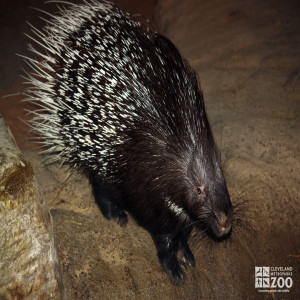Indian Crested Porcupine
[Hystrix indica]
 The Indian Crested Porcupine has a head and body length can range from 23 to 36 inches; tail length from 3 to 6 inches, and weight from 22 to 66 pounds. The head, neck, shoulders, limbs and underside of the body are covered with coarse, dark brown or black bristles. There are long quills along the head, nape and back, and these quills can be taised into a crest. The sides and back half of the body are covered with stout, cylindrical quills up to 14 inches long, and mostly marked with alternating light and dark bands. There may be some longer, more slender, and more flexible quills, usually all white. The rattle quills of the short tail are well developed. These rattle quills are located at the end of the tail. They are slender for most of their length but are of much greater diameter for the last fifth. The expanded portion is hollow and thin-walled, so that several quills vibrating together produce a hiss-like rattle. The broad forefoot has four well-developed digits, each equipped with a thick claw, and the hind foot has five digits. The eyes and external ears are very small. The facial region of the skull is inflated by pneumatic cavities, and the nasal bones are enlarged. Females have two or three pairs of lateral thoracic mammae.
The Indian Crested Porcupine has a head and body length can range from 23 to 36 inches; tail length from 3 to 6 inches, and weight from 22 to 66 pounds. The head, neck, shoulders, limbs and underside of the body are covered with coarse, dark brown or black bristles. There are long quills along the head, nape and back, and these quills can be taised into a crest. The sides and back half of the body are covered with stout, cylindrical quills up to 14 inches long, and mostly marked with alternating light and dark bands. There may be some longer, more slender, and more flexible quills, usually all white. The rattle quills of the short tail are well developed. These rattle quills are located at the end of the tail. They are slender for most of their length but are of much greater diameter for the last fifth. The expanded portion is hollow and thin-walled, so that several quills vibrating together produce a hiss-like rattle. The broad forefoot has four well-developed digits, each equipped with a thick claw, and the hind foot has five digits. The eyes and external ears are very small. The facial region of the skull is inflated by pneumatic cavities, and the nasal bones are enlarged. Females have two or three pairs of lateral thoracic mammae.
Location: Animals Formerly at Zoo
Share:
Range
The range of the Indian Crested Porcupine is from India to Arabia.Habitat
Indian Crested Porcupine's inhabit forests, plantations, rocky areas, mountain steppes & sandhill deserts, up to 11,000 feet elevation.Conservation Status
Least ConcernPrimary Threats
Gestation
About 112 days
Litter
1 to 4, but usually 1 or 2
Behavior
Indian Crested Porcupines are highly adaptable as to habitat. They shelter in caves, rock crevices, aardvark holes, or burrows that they dig themselves. The burrows often have several entrances, are sometimes used for many years, and can become quite extensive. Hystrix is nocturnal and terrestrial. It does not usually climb trees, but is able to swim well. Its movement is described as “easy and graceful.” They tend to follow paths, and may cover up to 9 miles per night in search of food. Piping calls and a pig-like grunt have been reported. There is considerable grunting and quill rattling as they shuffle around at night. When they encounter another animal they raise and fan their quills, more than doubling their apparent size. If still bothered they stamp their feet, whirr their quills, then finally charge backward, attempting to drive the thicker, shorter quills of the rump into the enemy. Lions, leopards, hyenas and even humans are sometimes injured or killed in this manner. Small family groups commonly share a burrow, but the female may establish a separate den in which to bear her young.
Reproduction
Indian Crested Porcupines breed from March to December in India. The estrous cycle is about 35 days, and the gestation period about 112 days. Young are born in a grass-lined chamber within the burrow, and are well developed at birth. Females reach sexual maturity at 9 to 16 months, and males at 8 to 18 months. In Arabia Hystrix indica is killed on sight by farmers, and is rare in this region.
Wild Diet
Bark, roots, tubers, rhizomes, bulbs, fallen fruits, cultivated crops, insects and small vertebrates
Zoo Diet
Fruits, Vegetables, Rodent Chow.

